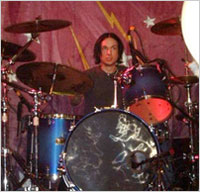Chris Vrenna: In the Studio with Pro Tools | ||
|
Audiohead | ||
|
The Ice Age of Audio Vrenna first learned sequencing back in 1986-1988 using Performer on a Mac Plus, while Trent was working on “Pretty Hate Machine.” But then Opcode put out StudioVision with combined audio and MIDI programming for the Mac. Pro Tools had two-channel stereo audio recording, but StudioVision provided a way to combine the benefits of Pro Tools audio with MIDI.
Pro Tools Wins His Rig But, the same week that StudioVision died, Vrenna got a free Pro Tools CD in the mail. “It was pretty featureless demo, but it functioned exactly like StudioVision did. So without even opening the manual, in 10 minutes I went, ‘Oh… grabby hand, oh, piano roll keyboard… Hmmmm I can’t do this, but I can do this… and by the end of the day I forgot what program I was using, and years later, I’m still using Pro Tools,” explains Vrenna. “I just never clicked with another program like I did with Pro Tools. “Plus, I do so much work with other people, and every studio has a Pro Tools rig. So, I can easily interact with those studios. When I bring a song in, or want to take files back from a studio, I can burn them and they’ll load right up on my home computer,” he says. “It’s just so interchangeable, where some other programs are not. “You know, there are so many choices out there and even at my own house, if someone says, ‘Can you put some distortion on this?’ Okay, I’ve got 20 distortion pedals, I’ve got four pieces of rack gear, I’ve got nine plug-ins, there are so many options,” explains Vrenna. “If I need a synth bay sound, I’ve got a stack of hardware synths, a stack of software synths… so it’s like, ‘What do we want to use?’ But there becomes a point at which everybody is becoming just so engrossed with the technology that sometimes they forget about the creative part.” No Tricky Sound Design Software Vrenna doesn’t use any software outside of Pro Tools for sound design. Mostly, he just tweaks the sounds brought in from his favorite synths with Pro Tools. “I have my favorite outboard synths — the Nord 2, the original Virus and Andromeda A6, which is just my new baby. God, that thing is good!” he exclaims. “It’s got 16-voice, all real analog,” he says. “I have a lot of outboard weird stuff,“ says Vrenna. “But I admit that the Virus plug-in is much easier to program because it’s just this screen full of big huge knobs instead of ‘shift-hold-parameter scroll… scroll… scroll…’ So it does make it easier for programming. But sometimes I just want to beat on the thing!” He’s still adding to the palette and just got a copy of Ableton’s Live. “And I live and die by Cycling ’74 Pluggo,” he adds. Home-based Pro Results “One of the cool things about computers is that no matter what software you’re using and whether you’re using an Mbox or whatever, you can do cool interesting things at home and get cool, professional sounding results,” says Vrenna. “I started out using Macs because they were the only computers that could run all of the music software I needed back when I started doing music on computers. But even today, Macs are still just more intuitive and easy to use,” he adds. When asked whether advances in audio software/hardware have made his job and life easier, he responds, “Absolutely! The ability to make pro-quality records at home, or just about anywhere a laptop can go, has changed the way records are made. I can deliver records now much cheaper, and often faster than before, with no sacrifices. Always Sing at Home “I always record vocals at home because — what? you need a good microphone, a good mic pre-amp, and you need your software to record it to. So why would I want to spend a band’s money sitting in a studio, at $500 a day or $1,000 a day to use one mic?” says Vrenna. “And you just need a quiet space to do it in, without air conditioning hums and such. So, no matter how big the budget is, we do vocals at home, because you can and technology allows us to do that,” he adds. Previous page: The First Tweaker Record and Remixing U2 |
|
|
|
